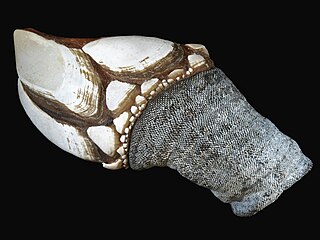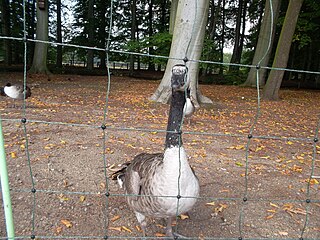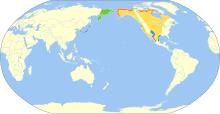
The nene, also known as the nēnē or the Hawaiian goose, is a species of bird endemic to the Hawaiian Islands. The nene is exclusively found in the wild on the islands of Oahu, Maui, Kauaʻi, Molokai, and Hawaiʻi. In 1957, it was designated as the official state bird of the state of Hawaiʻi.

The greylag goose or graylag goose is a species of large goose in the waterfowl family Anatidae and the type species of the genus Anser. It has mottled and barred grey and white plumage and an orange beak and pink legs. A large bird, it measures between 74 and 91 centimetres in length, with an average weight of 3.3 kilograms. Its distribution is widespread, with birds from the north of its range in Europe and Asia often migrating southwards to spend the winter in warmer places, although many population are resident, even in the north. It is the ancestor of most breeds of domestic goose, having been domesticated at least as early as 1360 BCE. The genus name and specific epithet are from anser, the Latin for "goose".

The snow goose is a species of goose native to North America. Both white and dark morphs exist, the latter often known as blue goose. Its name derives from the typically white plumage. The species was previously placed in the genus Chen, but is now typically included in the "gray goose" genus Anser.

The barnacle goose is a species of goose that belongs to the genus Branta of black geese, which contains species with largely black plumage, distinguishing them from the grey Anser species. Despite its superficial similarity to the brant goose, genetic analysis has shown it is an eastern derivative of the cackling goose lineage.

The red-breasted goose is a brightly marked species of goose in the genus Branta from Eurasia. It is currently classified as vulnerable by the IUCN.

The Canada goose, sometimes called Canadian goose, is a large wild goose with a black head and neck, white cheeks, white under its chin, and a brown body. It is native to the arctic and temperate regions of North America, and it is occasionally found during migration across the Atlantic in northern Europe. It has been introduced to France, the United Kingdom, Ireland, Finland, Sweden, Denmark, New Zealand, Japan, Chile, Argentina, and the Falkland Islands. Like most geese, the Canada goose is primarily herbivorous and normally migratory; often found on or close to fresh water, the Canada goose is also common in brackish marshes, estuaries, and lagoons.

The black geese of the genus Branta are waterfowl belonging to the true geese and swans subfamily Anserinae. They occur in the northern coastal regions of the Palearctic and all over North America, migrating to more southerly coasts in winter, and as resident birds in the Hawaiian Islands. Alone in the Southern Hemisphere, a self-sustaining feral population derived from introduced Canada geese is also found in New Zealand.

Goose barnacles, also called stalked barnacles or gooseneck barnacles, are filter-feeding crustaceans that live attached to hard surfaces of rocks and flotsam in the ocean intertidal zone. Goose barnacles formerly made up the taxonomic order Pedunculata, but the group has been found to be polyphyletic, with its members scattered across multiple orders of the infraclass Thoracica.
Percy Algernon Taverner was a Canadian ornithologist and architect.

The brant or brent goose is a small goose of the genus Branta. There are three subspecies, all of which winter along temperate-zone sea-coasts and breed on the high-Arctic tundra.

Anser is a waterfowl genus that includes the grey geese and the white geese. It belongs to the true goose and swan subfamily of Anserinae under the family of Anatidae. The genus has a Holarctic distribution, with at least one species breeding in any open, wet habitats in the subarctic and cool temperate regions of the Northern Hemisphere in summer. Some also breed farther south, reaching into warm temperate regions. They mostly migrate south in winter, typically to regions in the temperate zone between the January 0 °C (32 °F) and 5 °C (41 °F) isotherms.
The nēnē-nui or wood-walking goose is an extinct species of goose that once inhabited Maui and possibly Kauaʻi, Oʻahu and perhaps Molokaʻi in the Hawaiian Islands. It is known from a large number of subfossil bones found in Holocene cave sediments.
Canadensis is a Neo-Latin term meaning of Canada, used in taxonomy to denote species indigenous to or strongly associated with Canada.

The Aleutian cackling goose is a small subspecies of the cackling goose averaging 1.7 to 2.1 kg in weight. It was one of 122 species of animals, birds, and fishes first documented for science by the Lewis and Clark Expedition.
The dusky Canada goose is a subspecies of the Canada goose. They are the darkest variant, similar to the Pacific cackling goose. Tagged dusky geese have red bands with white letters on them attached to their neck. They represent one of the smallest populations of Canada goose in the Pacific Northwest. Due to the species' minimal population and exclusive breeding grounds, the dusky Canada goose is a species of interest to the Pacific Flyway Council and the U.S. Forest Service. The Cordova Ranger District, on the Chugach National Forest, has been working since 1984 to implement a monitoring and restoration program for the geese.

The giant Canada goose is the largest subspecies of Canada goose, on average weighing in at 5 kg. It is found in central North America. These geese were at one point considered extinct, but were later rediscovered. The giant Canada goose was once kept and bred in captivity for use as hunting decoys and for food.

The Moffitt's Canada goose, also known as the Western Canada goose or Great Basin Canada Goose is a subspecies of the Canada goose. Native to the western interior of North America surrounding the Rocky Mountains, its range has expanded due to introductions to various regions of western North America.

The small cackling goose, also known as the Ridgway's goose, is the smallest subspecies of cackling goose and the smallest variant of white-cheeked goose.
The Vancouver Canada goose is a subspecies of Canada goose, residing in western British Columbia and southern Alaska.


















